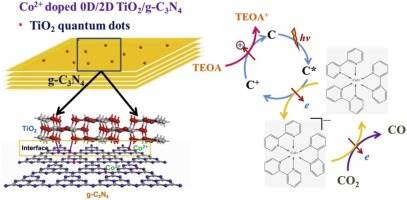Journal of CO2 Utilization ( IF 7.2 ) Pub Date : 2020-01-13 , DOI: 10.1016/j.jcou.2020.01.005 Hainan Shi , Jun Du , Jungang Hou , Wenjun Ni , Chunshan Song , Keyan Li , Gagik G. Gurzadyan , Xinwen Guo

|
Low charge separation efficiency is the critical limitation for solar-driven CO2 conversion into chemicals fuels. Accelerating charge transfer in the interface of photocatalysts is an intriguing approach to suppress charge recombination. Herein, Co2+ doped 0D/2D TiO2 quantum dots confined in graphitic carbon nitride (CoTiCN) heterostructure was prepared by in-situ pyrolysis of MOFs and urea. Co2+ serves as the bridge of linking 0D TiO2 and 2D g-C3N4 in the interface, and consequently accelerates charge transfer in the interface from 2D g-C3N4 to 0D TiO2. As a result, CO evolution rate for photocatalytic CO2 reduction reached 290 μmol g−1 h−1, much higher than those of pure g-C3N4 and TiO2/g-C3N4. In addition, photocatalytic mechanism study indicates that [Co(bpy)3]Cl2 in the system functions as cocatalyst without any photocatalytic activity under visible light irradiation. Electron transfer occurs from heterogeneous photocatalyst to [Co(bpy)3]Cl2, which acts as the electron transporter as active sites to catalyze CO2 reduction into CO. This work provides an insight into the design of metal doped 0D/2D material towards visible light driven CO2 reduction from the viewpoint of promoting charge transfer in the interface and the understanding of the photocatalytic mechanism of cocatalyst in system.
中文翻译:

掺杂Co 2+的0D / 2D TiO 2 / gC 3 N 4异质结构上的太阳能驱动的CO 2转化:深入了解Co 2+和助催化剂的作用
电荷分离效率低是将太阳能驱动的CO 2转化为化学燃料的关键限制。加速光催化剂界面中的电荷转移是一种抑制电荷复合的有趣方法。在此,通过MOF和尿素的原位热解制备了局限在石墨氮化碳(CoTiCN)异质结构中的Co 2+掺杂的0D / 2D TiO 2量子点。Co 2+充当界面中连接0D TiO 2和2D gC 3 N 4的桥梁,因此加速了界面中电荷从2D gC 3 N 4到0D TiO 2的转移。。结果,用于光催化CO 2还原的CO放出速率达到290μmolg -1 h -1,远高于纯gC 3 N 4和TiO 2 / gC 3 N 4的放出速率。此外,光催化机理的研究表明,系统中的[Co(bpy)3 ] Cl 2在可见光照射下作为助催化剂而没有任何光催化活性。电子从非均相光催化剂转移到[Co(bpy)3 ] Cl 2,后者充当电子转运体,成为催化CO 2的活性位点从促进界面中电荷转移和了解系统中助催化剂的光催化机理的角度,这项工作为深入研究金属掺杂的0D / 2D材料在可见光驱动的CO 2还原方面的设计提供了见识。











































 京公网安备 11010802027423号
京公网安备 11010802027423号